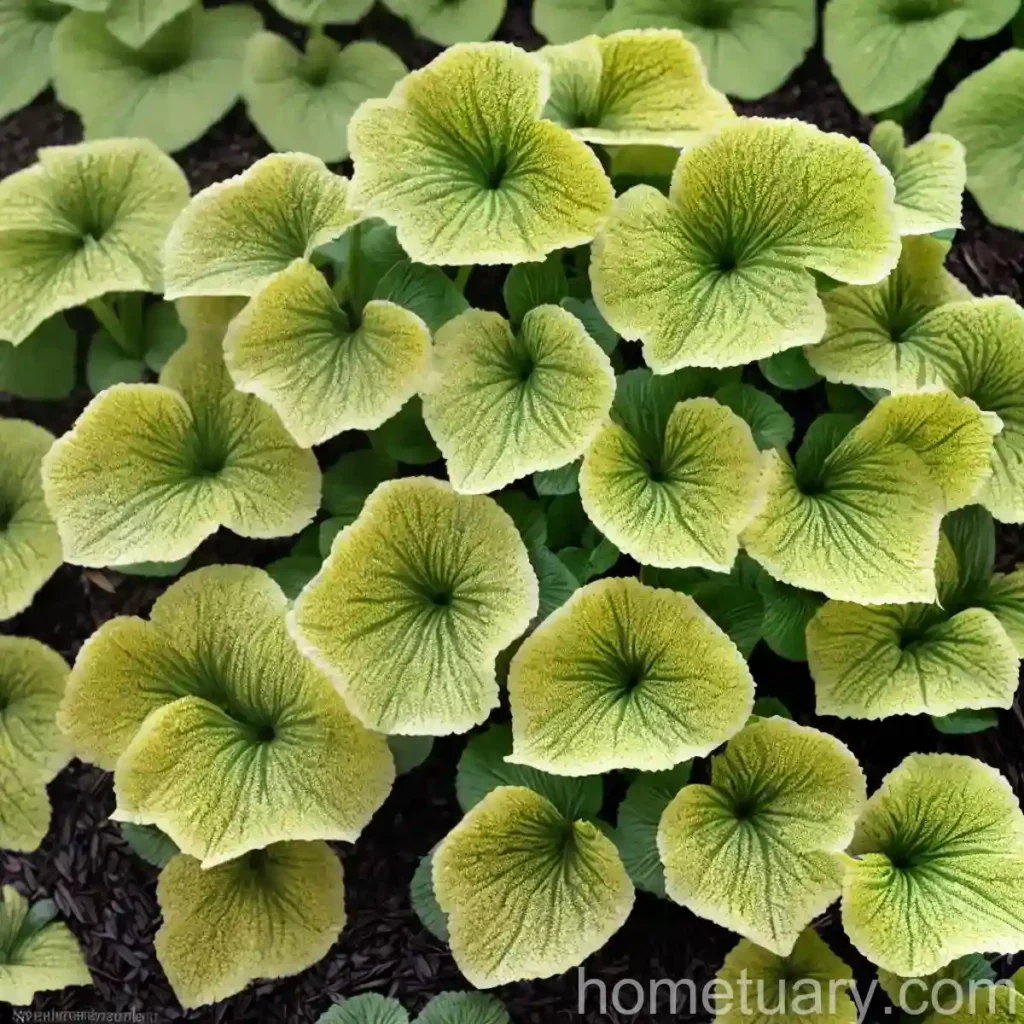Siberian Bugloss (Brunnera macrophylla ‘Spring Yellow’)
Siberian bugloss, scientifically known as Brunnera macrophylla ‘Spring Yellow’, is a captivating perennial plant that is cherished for its stunning ornamental foliage and delicate blue flowers. Renowned for its resilience and adaptability, it is a valuable addition to any shade garden, bringing vibrancy and life to often overlooked areas. In this comprehensive guide, we will delve into the various facets of Siberian bugloss, from its cultural requirements to its propagation and common pests. Whether you are a seasoned gardener or just beginning to explore the realm of ornamental plants, this article aims to equip you with the knowledge needed to cultivate and appreciate this charming perennial.
What is Siberian Bugloss (Brunnera macrophylla ‘Spring Yellow’)?
Siberian bugloss, also known as Brunnera macrophylla ‘Spring Yellow’, belongs to the Boraginaceae family and is native to the woodlands of Eastern Europe and Western Asia. The genus Brunnera is comprised of just a handful of species, with Brunnera macrophylla being the most popular among gardeners due to its ornamental qualities. ‘Spring Yellow’ is a cultivar of Brunnera macrophylla and is esteemed for its striking yellow variegated foliage that adds a touch of brightness to shaded areas.
Key Takeaways – Siberian Bugloss (Brunnera macrophylla ‘Spring Yellow’)
- Scientific Name: Brunnera macrophylla ‘Spring Yellow’
- Common Name: Siberian Bugloss
- Family: Boraginaceae
- Origin: Eastern Europe and Western Asia
- Cultivar: ‘Spring Yellow’
- Foliage: Variegated with yellow
- Flowers: Delicate blue flowers in spring
- Growth Habit: Clump-forming perennial
- Hardiness Zones: 3-8
- Best Suited for: Shade gardens, woodland areas
Now, let’s delve into the various aspects of cultivating and caring for Siberian bugloss, from its cultural requirements to common diseases and pests.
Culture
Siberian bugloss, with its captivating foliage and delicate blue flowers, thrives in a shaded environment with moist, well-draining soil. When it comes to its cultural requirements, understanding its preferred conditions is essential for fostering its growth and ensuring it thrives in your garden.
Uses
Siberian bugloss is valued for its ornamental attributes, particularly its variegated yellow foliage, which adds a pop of color to shaded areas. It is commonly employed in landscaping and gardening for the following purposes:
- Ground Cover: The low-growing, clump-forming habit of Siberian bugloss makes it an excellent choice for ground cover in shaded areas.
- Borders and Edging: Its attractive foliage and delicate blooms make it ideal for borders and edging in woodland gardens.
Water
Adequate moisture is crucial for the optimal growth of Siberian bugloss, especially during its active growing season. While it is important to avoid waterlogged conditions, consistently moist soil is beneficial for this perennial. Here are some key points to consider regarding its water requirements:
- Watering Frequency: Regular watering, especially during hot and dry periods, is essential to maintain soil moisture levels.
- Mulching: Applying a layer of organic mulch around the base of the plant helps retain soil moisture and regulates the temperature of the root zone.
Sunlight
As a shade-loving plant, Siberian bugloss thrives in environments with dappled or partial shade. Exposure to direct sunlight can lead to scorching of the delicate foliage, making it crucial to provide the right amount of shade for the plant. Here are some considerations relating to its sunlight requirements:
- Shade Preferences: Filtered sunlight or partial shade is ideal for Siberian bugloss, particularly in the afternoon when the sun is more intense.
- Dappled Shade: Planting it under the canopy of trees or near taller shrubs provides the perfect dappled shade it requires.
Fertilizer
While Siberian bugloss is not overly demanding in terms of fertilizer, providing it with a nutrient boost can enhance its growth and overall vigor. Careful application of fertilizer ensures that the plant receives the essential nutrients without risking over-fertilization. Here are some guidelines for fertilizing Siberian bugloss:
- Timing: Apply a balanced, slow-release fertilizer in early spring as the plant emerges from dormancy.
- Frequency: A single application of fertilizer in spring is usually sufficient for sustaining its growth throughout the season.
- Avoid Excess: Refrain from over-fertilizing to prevent excessive foliage growth at the expense of flower production.
Soil
The soil composition and quality play a pivotal role in the successful cultivation of Siberian bugloss. Its preference for humus-rich, well-draining soil is a crucial factor to consider when selecting the planting site and preparing the soil. Here are some key soil-related considerations for Siberian bugloss:
- Acidic Soil: It thrives in slightly acidic to neutral soil with a pH range of 6.0-7.5.
- Organic Matter: Incorporating organic matter such as compost or well-rotted manure enhances soil structure and fertility.
- Drainage: Ensuring good drainage is imperative to prevent waterlogging, which can be detrimental to the plant’s health.
Pruning
Pruning Siberian bugloss is a straightforward task that primarily focuses on maintaining its desired shape, preventing self-seeding, and reviving the plant’s vigor. Understanding the appropriate timing and techniques for pruning is essential to ensure the plant’s health and longevity. Here are some key points to consider when it comes to pruning Siberian bugloss:
- Timing: Prune Siberian bugloss in early spring before new growth emerges to remove any damaged or discolored foliage and encourage a fresh flush of growth.
- Deadheading: Removing spent flowers promotes continuous blooming and prevents self-seeding.
- Cleaning and Thinning: Periodically remove any dead or tired-looking foliage to maintain the plant’s attractive appearance and improve air circulation.
Propagation
Propagating Siberian bugloss allows you to expand your collection of these charming perennials without having to purchase new plants. Understanding the various propagation methods enables you to propagate Siberian bugloss successfully and develop a stronger connection with the plant. Here are the primary methods for propagating Siberian bugloss:
- Division: Divide mature clumps of Siberian bugloss in early spring to create new plants. Gently separate the root mass and replant the divisions in prepared soil.
- Seed Propagation: Collect seeds from mature plants after the flowering period. Sow the seeds in containers or directly in the garden in early fall or spring.
Container Popularity
As a versatile and visually striking plant, Siberian bugloss holds significant appeal for container gardening. Its shade tolerance and compact growth habit make it an excellent candidate for container cultivation. Whether you have limited garden space or simply want to brighten up your patio or balcony, growing Siberian bugloss in containers is a rewarding endeavor.
Container Common Diseases
While container gardening offers numerous benefits, it is crucial to be aware of potential diseases that can affect plants in containers, including Siberian bugloss. By understanding common diseases and taking preventive measures, you can ensure the health and vitality of your container-grown Siberian bugloss.
Disease Diagnosis
Diagnosing diseases in container-grown Siberian bugloss involves observing the plant for symptoms of common ailments and taking proactive measures to address any issues. Familiarizing yourself with common diseases and their symptoms equips you with the knowledge needed to identify and treat potential problems effectively.
Common Pests
Pests can pose a threat to container-grown Siberian bugloss, impacting its growth and overall health. By understanding the common pests that may target this plant, you can implement proactive measures to manage and prevent pest infestations effectively.
Botanist’s Tips
As a plant scientist with a passion for Siberian bugloss, I have gathered valuable insights and tips for cultivating and appreciating this enchanting perennial. Drawing from my expertise and experiences, I offer the following tips to enhance your journey with Siberian bugloss:
Fun Facts
Siberian bugloss boasts a fascinating heritage and a range of unique characteristics that make it an intriguing plant to study and cultivate. Here are some fun facts about Siberian bugloss that showcase its distinctive qualities and appeal:
- Leaf Variegation: The variegated foliage of Siberian bugloss is a prominent feature, with the ‘Spring Yellow’ cultivar standing out for its vibrant yellow-toned leaves.
- Deer Resistance: Siberian bugloss exhibits good resistance to deer browsing, making it a valuable addition to gardens frequented by these animals.
- Woodland Native: With its origins in the woodlands of Eastern Europe and Western Asia, Siberian bugloss is well-adapted to shaded environments.
Links to External Resources
To further expand your knowledge and understanding of Siberian bugloss, I recommend exploring the following external resources:
- The American Horticultural Society’s Encyclopedia of Plants & Flowers – A comprehensive guide that provides in-depth information about a wide range of plants, including Siberian bugloss.
- The Royal Horticultural Society (RHS) Plant Finder – An extensive database that offers detailed plant profiles and cultivation advice, including guidance on growing Siberian bugloss.
- The Gardening Channel – A valuable online resource offering articles, tips, and videos on various aspects of gardening, including the cultivation of shade-loving plants such as Siberian bugloss.
In conclusion, Siberian bugloss (Brunnera macrophylla ‘Spring Yellow’) stands out as a captivating and resilient perennial that holds immense appeal for shade gardens and woodland landscapes. By understanding its cultural requirements, propagation methods, and potential challenges such as diseases and pests, you can cultivate and appreciate this charming plant with confidence and success. Whether you are a novice gardener or a seasoned horticultural enthusiast, Siberian bugloss offers a wealth of ornamental and practical benefits, making it a valuable addition to any garden space.















